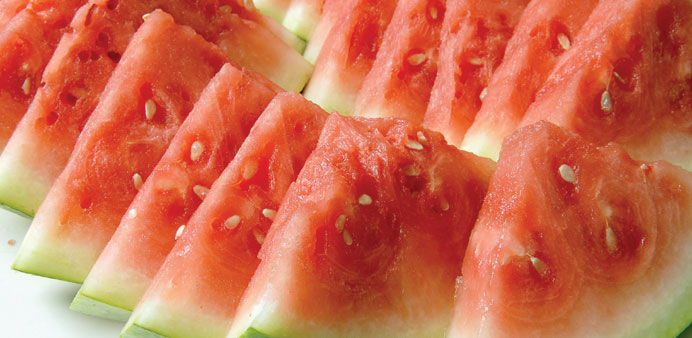Nutritional benefits round out watermelon’s scrumptious taste. By David Templeton
Watermelon may be the best picnic dessert nature ever created with its sweet juice cleverly bound inside that spongy red (sometimes yellow) matrix, and fully protected by psychedelic green rind.
Talk about a party orb.
But much like the thespian whose good looks overshadow brilliant acting skills, the watermelon’s sweet, colorful qualities long have undercut its attributes as a wholly nutritious fruit whose tasty powers hydrate as well as heal.
And no matter how you slice it, this green cannonball of nutrition is attracting scientific attention as an elixir that reduces muscle pain after workouts and a whole lot more. Studies also have shown beneficial effects on arterial plaque in cardiovascular disease, prostate and other cancers, erectile dysfunction, menopause, acid reflux and potentially Alzheimer’s disease, among others.
A recent study, for example, found that “watermelon extract supplementation reduces blood pressure and arterial stiffness,” in older adults in cold weather, so it “can prevent the progression of hypertension and the hypertensive response to cold exposure,” said the author Arturo Figueroa-Galvez, associate professor at Florida State University’s department of nutrition, food and exercise sciences.
Another of his studies found that the supplement also reduced ankle blood pressure in obese adults with hypertension. Studies by others found that watermelon compounds reduced inflammation in prostate, gastrointestinal and other cancers, while a study published recently showed that lycopene, which provides the red pigmentation in watermelon and tomatoes, potentially reduced the inflammatory cascade of Alzheimer’s disease.
In April yet another study found lycopene reduced reflux disease in animals, in part, by inhibiting acid pathways in the stomach.
“Watermelon is a pretty well-documented source of vitamin C, vitamin A and potassium,” said Penelope Perkins-Veazie, a professor of horticulture in the Plants for Human Health Institute at North Carolina State University. She said she’s been studying watermelon nutrients for 15 years.
Most noteworthy are watermelon’s two “secondary metabolites,” citrulline and lycopene, which have been the focus of recent research. Citrulline, a nonessential amino acid, is abundant in watermelon, yellow watermelons having four times that of red watermelon.
As it turns out, citrulline is involved in producing nitric oxide, a potent molecule that relaxes blood vessels and lowers blood pressure, “with benefits to the brain, heart and in a cycle of amino acids necessary to properly flush the kidneys,” said Perkin’s Veazie, who has a PhD in horticulture.
Lycopene is actually more abundant and more easily available in watermelon than tomatoes, where it’s bound up in cellular walls, even if tomatoes draw more research attention due to their importance in the American diet. Perkins-Veazie said lycopene shows clear benefits in reducing plaque buildup in arteries and preventing prostate cancer.
Botanically, watermelon is a fruit in the same cucurbit family as pumpkins, squash and cucumbers, which often are mistaken as vegetables. The longstanding bias against watermelon stems from its 21 grams of carbohydrates, mostly sugars, in every two-cup serving, with only a single gram of fibre. “People are concerned about the sugar, but compared to processed products it tastes sweet but isn’t loaded with sugar,” Perkins-Veazie said. “It’s counterintuitive, but there is an enzyme present to regulate the glucose.”
Despite the sugars (equally divided among sucrose, glucose and fructose), two cups of watermelon have only 80 calories with no fat, sodium or cholesterol. “Using the same watermelon extract used in my previous human studies, watermelon supplementation did not increase body weight and improved blood lipids in rats,” Dr Figueroa-Galvez said.
Watermelon originated in southern Africa and became nature’s canteen. Rather than transport water long distances, travellers took watermelons, which are 92% water and don’t begin rotting for three weeks.
In the US, watermelon’s key season July with a tag team of suppliers from Florida in April, followed by Texas and Georgia, before California supplies the country with watermelons through October. During winter months, Mexico and Guatemala are the source.
Stephanie Barlow, spokeswoman for the National Watermelon Promotion Board, said the fruit offers consumers health, value and versatility all year-round, all parts being edible, including the rind and seeds. “We’re really focusing on health,” she said. “All pre-packaged foods have a smattering of health claims so our health message has to be the strongest one.”
There are 1,200 varieties of watermelon grown in 96 countries, she said, noting that square ones are being grown in square containers in Japan so they fit into smaller refrigerators. There are even a few orange watermelons.
The 100 seeds in a watermelon are heavier than the flesh, she said, and act like marbles, damaging the flesh and causing them to rot more quickly. That helps explain why in the market today, she said, “It’s a landslide majority of seedless watermelons.” — Pittsburgh Post-Gazette/TNS

